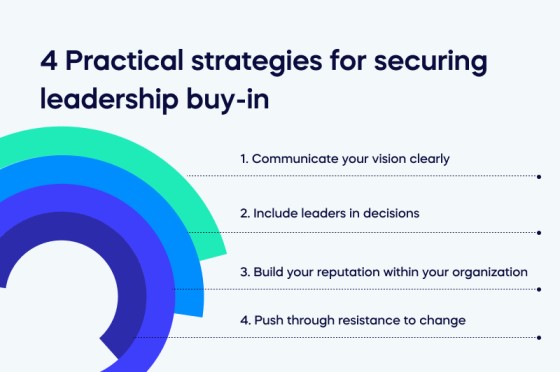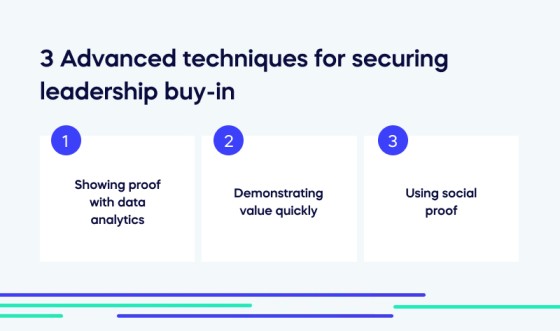Leadership buy-in refers to the authentic agreement and active support from your leadership team towards a shared goal or vision.
It’s about more than just superficially agreeing to a plan.
It’s about believing in the vision, understanding it, and being ready to actively contribute to its achievement.
Why is leadership buy-in so important?
Consider this – without the support of your leadership, even the most well-crafted vision can fall flat.
Your vision is the guiding light for business transformation. It gives your team a sense of direction and a shared goal to strive towards.
But without their buy-in, your vision might not get the traction it needs to come to life.
Getting leadership buy-in promotes transformational leadership, which:
- Drives alignment
- Fosters commitment
- Accelerates the realization of your vision
In this article, we aim to delve deeper into why leadership buy-in is critical for realizing your vision, and we’ll be sharing practical strategies to secure it.
We’ll start with simpler, more practical techniques you can start with immediately, then we’ll dive into more advanced techniques.
Understanding the importance of leadership buy-in
Why does leadership buy-in matter?
As a leader, you might think having a great vision is enough. However, a vision is only as good as the team’s willingness and ability to execute it. That’s where leadership buy-in comes into play.
Leadership buy-in is mission-critical for several reasons. Firstly, it cultivates a unified direction.
When the leaders in your organization align with your vision, they work in tandem to achieve common goals. This unity promotes collaboration and fosters a culture of shared responsibility.
Secondly, leadership buy-in helps streamline decision-making.
When leaders understand and support the vision, they can make decisions that align with the overall objectives. It reduces friction and accelerates progress by ensuring everyone is on the same page.
Moreover, leadership buy-in boosts morale and engagement.
When leaders are engaged and enthusiastic about a vision, it trickles down to the employees. It inspires trust, drives motivation, and can significantly increase productivity.
But what happens when there’s a lack of leadership buy-in?
Simply put, your vision may stall or even fail.
When leaders aren’t bought in, they may not fully support or implement your vision, leading to confusion, misalignment, and low morale among your team.
It could result in conflicting decisions, inconsistent messaging, and an overall lack of progress toward the vision. It might even breed skepticism and resistance toward future initiatives.
The Inherent Problem describes how the biggest waste of time in an organization is the requirement of leadership to approve decisions – which is why you want them to buy into your vision and simply let you execute without getting in your way.
In essence, securing leadership buy-in is not just a nice-to-have. It’s a must-have.
Without it, you risk jeopardizing the execution of your vision and the overall success of your organization.
The connection between leadership buy-in and vision success
Leaders actively supporting your vision can trigger a cascade of positive outcomes within your organization.
When leaders buy in, they don’t just nod in agreement. They take action.
They initiate conversations about the vision, align their decisions and actions with it, and advocate for it within their teams.
They’re not just passively on board. They’re actively steering the ship in the direction you want to go.
Their actions contribute to a ripple effect throughout the business.
Teams start to see the vision in their everyday work, and it becomes more tangible. They understand what they are working towards and how their tasks contribute to the bigger picture.
This understanding can significantly boost engagement and productivity.
Moreover, leadership buy-in fosters an environment of trust.
Leaders visibly supporting the vision signals to the employees that it is worthwhile and achievable. This belief can reinforce their trust in you as a leader and in the organization’s overall direction.
Understanding this dynamic is key to harnessing the power of leadership buy-in. It’s not just about getting leaders to say “yes” to your vision. It’s about inspiring them to lead the charge toward it.
With their active support, your vision stands a much stronger chance of being realized.
Challenges in achieving leadership buy-in
Getting leadership buy-in isn’t always a walk in the park.
You may encounter several obstacles when trying to secure buy-in from your leadership team.
One common challenge is resistance to change.
Humans are creatures of habit, and leaders are no exception.
If your vision involves significant changes to the status quo, you might face some pushback. Leaders may be comfortable with the current state of affairs or fear the unknowns that come with change.
Another hurdle could be a lack of clear communication.
If leaders don’t fully understand the vision or the reasons behind it, they may be hesitant to buy in.
Similarly, if the vision isn’t communicated with conviction or there’s ambiguity in the messaging, it could sow seeds of doubt among your leaders.
Leaders may also have differing opinions or priorities.
Sometimes, they might have their own vision or goals that conflict with yours. These disagreements can lead to tension and hinder the achievement of buy-in.
Recognizing these potential roadblocks is the first step toward overcoming them.
By addressing these challenges directly and strategically, you can foster a culture of buy-in that propels your vision forward.
In the next section, we’ll discuss practical strategies to do just that.
4 Practical strategies for securing leadership buy-in

These four strategies can help you overcome potential challenges and foster an environment conducive to realizing your vision.
Implementing these strategies can significantly increase your chances of securing leadership buy-in.
Remember, it’s a process that takes time, patience, and persistence. But the payoff – a fully engaged leadership team propelling your vision forward – is well worth the effort.
1. Communicate your vision clearly
Effective communication is the cornerstone of leadership buy-in. It’s about what you’re communicating and how you share it.
Make sure your vision is clear, compelling, and concise.
Explain not just the what and the how but also the why – why the vision matters, why it’s worth pursuing, and why each leader’s contribution is essential.
Use compelling narratives, data, and examples to strengthen your case.
2. Include leaders in decisions
Inclusive decision-making is another powerful strategy.
Involve your leaders in shaping the vision and the strategy to achieve it. Make them feel like co-owners of the vision, not just recipients of it.
This participative approach can increase their sense of commitment and accountability.
3. Build your reputation within your organization
Building trust and credibility is crucial.
Leaders are more likely to buy into your vision if they trust you and perceive you as credible.
Be transparent about your intentions, open about challenges, and consistent in your actions. Demonstrate competence and integrity in all your interactions.
4. Push through resistance to change
Lastly, dealing with resistance to change is essential.
If leaders are resisting the vision, don’t dismiss their concerns. Instead, address them openly.
Understand the source of their resistance, provide reassurances, and show empathy. Demonstrate the benefits of the vision and the potential downsides of not pursuing it. Celebrate early wins and progress towards the vision to reinforce its viability and value.
3 Advanced techniques for securing leadership buy-in

Beyond the fundamental strategies, you can use advanced methods to strengthen your case for leadership buy-in.
These can be particularly helpful when dealing with resistant or skeptical leaders.
These advanced techniques can be highly effective in securing leadership buy-in. They can help you build a compelling case for your vision and overcome resistance.
With the right strategies, you can turn skeptics into advocates and drive your vision forward with the full support of your leadership team.
1. Showing proof with data analytics
A data-driven approach can be a powerful tool for persuasion.
If you can back your vision up with hard facts, statistics, or market research, it becomes much harder for leaders to dismiss it.
Use data to demonstrate the need for your vision, the potential benefits, and the risks of inaction. If possible, use predictive analytics to paint a picture of what success could look like.
2. Demonstrating value quickly
Showcasing quick wins and success stories is another effective strategy.
Leaders are more likely to buy into a vision if they can see tangible proof that it’s achievable. If you’ve already made some progress towards your vision, highlight this.
Share stories of early success, testimonials, or case studies that validate the direction you’re heading in.
3. Using social proof
Finally, consider utilizing external consultants or internal influencers.
External consultants can bring fresh perspectives and validate your vision with their expertise. Internal influencers, on the other hand, can help you build momentum from within.
If you can get key leaders on your side early on, they can advocate for your vision and influence their peers.
Securing leadership buy-in: The key to making your vision a reality
Securing leadership buy-in is not just a beneficial step in the process of vision realization. It’s essential.
It fosters unity, streamlines decision-making, boosts morale, and accelerates the journey from vision to reality.
Without it, your vision runs the risk of becoming a mere aspiration rather than an actionable plan.
Leadership buy-in requires a thoughtful and intentional approach, as outlined in this article.
The path to securing leadership buy-in is not always easy, but the effort you put into this journey can drastically shape the success of your vision.
As you apply the strategies we’ve shared, you’ll not only be working towards realizing your vision but also fostering a culture of shared responsibility and collective action – a win-win for you and your organization.

